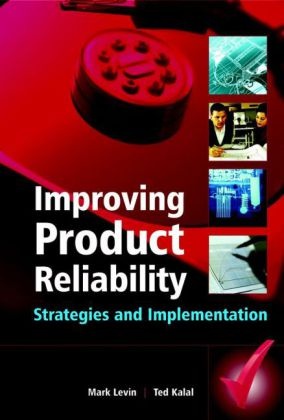Read more
If product reliability is falling short of customer expectations then changes are needed to the reliability process. Easy to understand, this practical guide offers advice to designers, engineers and managers who wish to develop better products but are unsure of what to do and how to go about it.
List of contents
About the Authors.
Series Foreword.
Foreword.
Preface.
Gaining Competitive Advantage.
List of Acronyms.
Acknowledgements.
PART I: Reliability - It's a Matter of Survival.
1 Competing in the Twenty-first Century.
1.1 Gaining competitive advantage.
1.2 Competing in the next decade - winners will compete on reliability.
1.3 Concurrent engineering.
1.4 Reducing the number of Engineering Change Orders (ECOs) at product release.
1.5 Time-to-market advantage.
1.6 Accelerating product development.
1.7 Identifying and managing risks.
1.8 ICM, a process to mitigate risk.
Reference.
2 Barriers to Implementing Reliability.
2.1 Lack of understanding.
2.2 Internal barriers.
2.3 Implementing change and change agents.
2.4 Building credibility.
2.5 Perceived external barriers.
2.6 It takes time to gain acceptance.
2.7 External barrier.
3 Understanding Why Products Fail.
3.1 Why things fail.
3.2 Parts have improved, everyone can build quality products.
3.3 Reliability - a twenty-first century paradigm shift.
References.
4 Alternative Approaches to Implement Reliability.
4.1 Hiring consultants.
4.2 Outsourcing reliability.
PART II: Unraveling the Mystery.
5 The Product Life Cycle.
5.1 Six phases of the product life cycle.
5.1.1 Mitigate risk.
5.2 The ICM process for a small company.
5.2.1 DFx - Design For Manufacturability (DFM), Design For Test (DFT), Design For Reliability (DFR), and Design For Serviceability (DFS).
5.2.2 Warranty.
References.
6 Reliability Concepts.
6.1 The bathtub curve.
6.2 Mean Time Between Failure.
6.2.1 Mean time between repair.
6.2.2 Mean Time Between Maintenances (MTBM).
6.2.3 Mean Time To Failure (MTTF).
6.2.4 Mean Time To Repair (MTTR).
6.2.5 Mean Time To Restore System (MTTRS).
6.3 Warranty costs.
6.4 Availability.
6.4.1 On-site manufacturer service personnel.
6.4.2 Customer trained service personnel.
6.4.3 Manufacturer training for customer service personnel.
6.4.4 Easy-to-Use service manuals.
6.4.5 Rapid diagnosis capability.
6.4.6 Repair and spare parts availability.
6.4.7 Rapid response to customer requests for service.
6.4.8 Failure data tracking.
6.5 Reliability growth.
6.6 Reliability demonstration testing.
References.
7 The Reliability Toolbox.
7.1 The FMEA process.
7.1.1 The functional block diagram.
7.1.2 The fault tree analysis.
7.1.3 Failure modes and effects analysis spreadsheet.
7.1.4 Preparing for the FMEA.
7.1.5 Barriers to the FMEA process.
7.1.6 FMEAs ground rules.
7.2 The HALT process.
7.2.1 Types of stresses applied in HALT.
7.2.2 The theory behind the HALT process.
7.2.3 HALT testing.
7.3 Highly accelerated stress screening (HASS).
7.3.1 Proof Of Screen (POS).
7.3.2 Burn-in.
7.3.3 Environmental Stress Screening (ESS).
7.3.4 Economic impact of HASS.
7.3.5 The HASA process.
7.4 Summary of HALT, HASS, HASA and POF benefits.
7.5 HALT and HASS test chambers.
7.6 SPC tool.
7.7 FIFO tool.
7.8 Component derating - a first line of defense in product reliability.
References.
8 Why Reliability Efforts Fail.
8.1 Lack of commitment to the reliability process.
8.2 Inability to embrace and mitigate technologies risk issues.
8.3 Choosing the wrong people for the job.
8.4 Inadequate funding.
8.5 Mil-Std 217/Bellcore - What they really do and why they don't work.
8.6 Finding but not fixing problems.
8.7 Nondynamic testing.
8.8 Vibration testing too difficult to implement.
8.9 Late software.
8.10 Supplier reliability.
References.
9 Supplier Management.
9.1 Purchasing interface.
9.2 Identifying your critical suppliers.
9.3 Develop a thorough supplier audit process.
9.4 Develop rapid nonconformance feedback.
9.5 Develop a Materials Review Board (MRB).
PART III: Three Steps to Successful Implementation.
10

